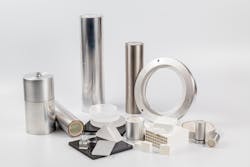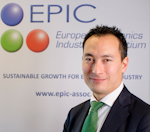Carlos Lee: What’s the background to you becoming managing director of Hilger Crystals?
Jim Telfer: After graduating with an MSc in Physics from the University of Glasgow in 1977, I joined Hilger as an R&D scientist. I worked in the area of materials science developing new crystals mainly for brain and body CT scanners and liaising with customers. Apart from a couple of years with Pilkington in the mid-1980s, I’ve stayed with Hilger ever since. I led their business development efforts in the mid-1980s, and in 1991, I was appointed managing director, a position I’ve held for the last 30 years with responsibility for leading research, engineering, sales, business development, and manufacturing.
CL: How has the company developed in that time?
JT: Hilger Crystals was founded in 1874, by two German brothers making scientific instruments. Then in the 1930s, they started growing crystals for the newly emerging spectroscopy market and in the 1950s developed crystals for x-ray technology and radiation detection. Since that time, we’ve developed processes for growing more than 15 types of scintillation crystals, like thallium-doped cesium iodide used in baggage scanning, as well as a range of optical imaging crystals, like potassium bromide used for IR spectrophotometers for medical applications like PET and CT imaging.
In the last 10 years, we’ve focused on developing greater accuracy to meet demands for higher resolution detectors, spectrometers, and x-ray imagers. This has meant developing smaller and more accurate crystals (see figure) and to do this, we’ve had to invest heavily—more than a couple million dollars—in more accurate, state-of-the-art machining equipment. Machines not only for producing smaller and more accurate crystals, but also metrology equipment for monitoring accuracy down to single-digit microns. As a result of our strategic investments, we’ve been able to develop robust industrial processes to meet those growing customer demands at scale.
From humble beginnings, we’ve grown to over 40 employees and we currently have over 70 furnaces that grow around 2000 kg of finished crystal each month.
CL: What are the main factors underlying your success?
JT: Hilger’s business strategy is based on three pillars: to be sustainable, best in class, and profitable.
After starting to grow crystals in the 1930s, we had a lot of competition, especially large companies in the U.S. and Europe—and now, of course, we have a lot of competitors in Asia. This stifled growth for a while and knowing we could never compete with the big players, we’ve concentrated on looking for gaps in the market and then developing strong, trusted relationships with our customers, who are mainly SMEs. By understanding and delivering exactly what they want, our customers have come back to us over the years because they know they’ll get the highest quality crystals, we’ll quickly resolve any technical or commercial issues, and that we’re easy to work with and flexible enough to meet their production schedules.
Our customers have come to see us like an extension of their company, and we’ve been able to carve out a profitable, sustainable, and high-tech niche business. Of course, nurturing relationships takes time: our last project took around eight years to develop into full-commercial production, but the relationship now contributes significantly to our annual revenues.
We’re also ISO-qualified: 9001 for quality, 14001 for environmental, and 45001 for occupational health and safety. This demonstrates our commitment and proactive focus on improving operational efficiency and productivity, and also that we pay close attention to our environmental impact and the health and safety of our employees.
Another crucial factor underlying our success has been our willingness and ability to invest for the future—that is, to make sure we have state-of-the-art equipment and the right people to develop our technology.
CL: What have been your main challenges?
JT: Recently, it’s been succession planning. Over the last few years, I’ve championed to strengthen our leadership bench that reports to me by setting up robust structures and guidelines they can work within, with the aim of keeping the tradition of what we’re good at for the future. The challenge has been identifying and grooming each person to ensure that we have a highly experienced cross-functional team that can lead us into the future. So, although we’re not there yet, we’ve made tremendous progress towards it.
Similarly, as regarding business, I’ve been spending quite a lot of time going to conferences, visiting customers, and analyzing data to create rolling five-year plans to make sure we have the technology available to provide solutions that will be required in the near future.
CL: How do you see the future?
JT: My vision is for Hilger to continue its transformation into a best-of-class, sustainable, and profitable provider of scintillation and detection solutions for IR spectroscopy. We continue to help and support our existing customers while spotting gaps in existing technologies and seeking opportunities that require us to come up with new solutions.
CL: What’s your advice for the next generation of entrepreneurs?
JT: There’s a saying that if you really enjoy your job, you never work. That’s how I feel because after 40 years working in the industry, I still get a kick out of seeing a new crystal material being developed from an idea to large-scale industrial production. So, the first thing I’d say is do something you’re passionate about because that will see you well through your career.
Of course, it’s important to find a company or the right environment that will give you the opportunities to grow professionally and allow you to develop your passion for a particular technology or profession. Looking back over the last 40 years, I know I’ve been fortunate working for Hilger—not only for the opportunities I’ve had, but also because of the support the company and my peers have given me over the past four decades.

